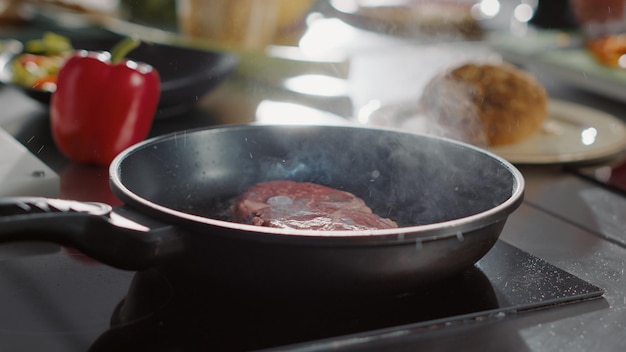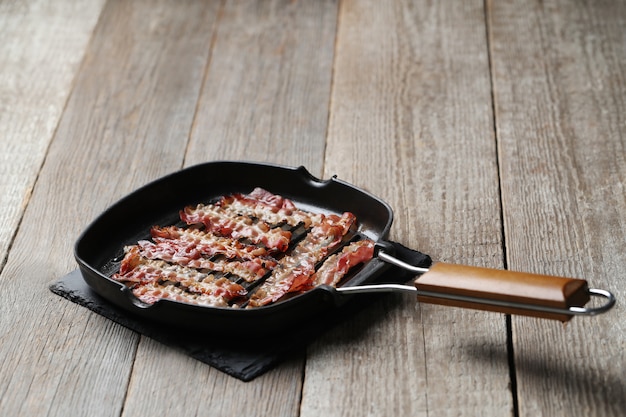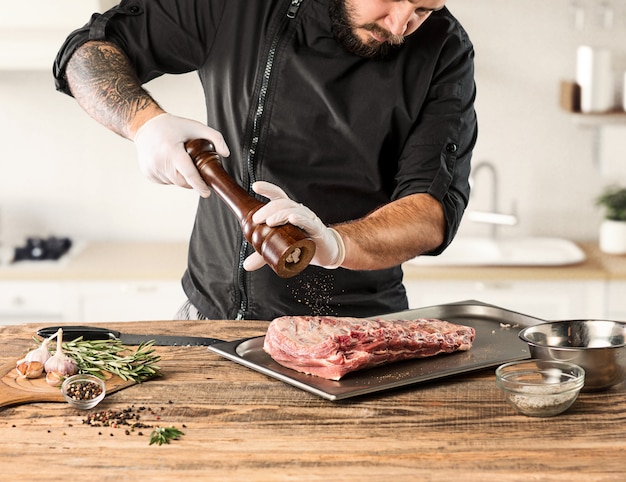Let's be real, flank steak is often overlooked. It gets overshadowed by those fancy cuts like ribeye and tenderloin, but trust me, it’s a real gem if you know how to handle it. A little tough if you're not careful, but when you get it right, the flavour? It's just phenomenal. That rich, beefy taste just melts in your mouth. And the best part? It doesn't need fancy equipment or hours of prep. A simple pan-frying method can turn out a delicious flank steak dinner in about 30 minutes.I've spent years experimenting with flank steak – trying different marinades, searing techniques, even grilling it over charcoal. But the method I've found to be the most reliable, the one that delivers consistently tender and flavorful results, is pan-frying. It's easy and really, really effective.This guide is going to take you step-by-step – from choosing the right flank steak to mastering the art of pan-frying. I'll be sharing some of my favorite marinades and tips for slicing and serving your steak like a pro. Ready to take your flank steak game to the next level? Let's get started!
(Part 1) choosing the right cut

First things first, you need to pick the right flank steak. This long, thin cut comes from the belly of the cow, and it's usually pretty lean. When you're at the butcher's, look for a steak that's about 1-1.5 inches thick and has a nice, even red colour. You want to avoid steaks that have a lot of fat or that look dry and discoloured.While you can find flank steak in most supermarkets, I'd recommend going to a butcher if you can. They usually have a wider selection, and they can help you pick the perfect cut for your needs. If you're unsure, just ask them about the marbling of the steak – the more marbling, the more tender it will be.
What to Look for in a Flank Steak
- Thickness: You want a steak that's about 1-1.5 inches thick. This ensures it cooks evenly and doesn't become overly dry.
- Marbling: Look for some marbling, which are those fat streaks running through the meat. Marbling adds flavour and helps keep the steak moist during cooking.
- Colour: A deep, even red colour is what you're aiming for. Avoid any that look dry or have discoloured areas.
(Part 2) Marinating for Maximum Flavour

Now, before you start cooking, let's talk marinades. A good marinade can really elevate the flavour of your flank steak, making it juicy and bursting with taste. I love playing around with different marinades, and I've learned that a good one should have a balance of acids, spices, and oils. The acids help tenderise the meat, the spices add that extra punch of flavour, and the oils help keep it moist.
My Favourite Marinades
These are my go-to marinades that I always come back to:
- Citrus Blast: A simple mix of lemon juice, olive oil, garlic, and herbs like oregano and thyme. This light and refreshing marinade is perfect for any flank steak.
- Spicy Tango: A blend of soy sauce, honey, garlic, ginger, and a dash of red pepper flakes. This marinade is packed with flavour and gives your steak a delicious kick. It's the one to choose if you like a little heat.
- Smokey Delight: A combination of smoked paprika, brown sugar, garlic, onion, and a touch of liquid smoke. This marinade brings a wonderful smoky aroma and flavour to the steak. You really can't go wrong with this one.
Tips for Marinating
Here are a few tips to get the most out of your marinade:
- Marinate for at least 2 hours, but up to 24 hours: This allows the flavours to penetrate the meat and create a more intense flavour profile. It's all about letting those flavours sink in.
- Keep the marinade refrigerated: This helps prevent bacteria growth and keeps your marinade fresh. food safety is important!
- Pat the steak dry before cooking: This ensures a good sear and prevents steam from forming, which can make the steak soggy. It's all about that crispy crust.
(Part 3) Preparing for Pan-Frying Perfection

Now that you've chosen your flank steak and marinated it to perfection, it's time to get ready for the pan-frying process. This is where the fun really begins! A well-executed pan-frying technique will give you that beautiful crust and juicy, tender interior we all crave.
The Right Pan and Heat
You'll need a heavy-bottomed pan, ideally cast iron or stainless steel. These pans distribute heat evenly and retain it well, ensuring a consistent sear. Make sure your pan is nice and hot before you add the steak – I'm talking medium-high heat, about 400°F (200°C). This is crucial for that perfect sear. We want that crust, right?
Oil of Choice
You want an oil with a high smoke point, like avocado oil or grapeseed oil. These oils can withstand high heat without burning and add a neutral flavour to your steak. Don't use olive oil for this; it has a low smoke point and will start to burn before the steak is cooked properly. That would be a disaster!
(Part 4) The Art of Pan-Frying
Alright, we're at the heart of the matter! This is where the magic happens. Pan-frying is all about timing, temperature, and technique. It's a little bit of a dance, but with a few simple steps, you'll be creating steak masterpieces in no time.
Step 1: Sear the Steak
When your pan is nice and hot, add a tablespoon of oil and let it heat up. Gently place your flank steak in the pan and let it cook undisturbed for 3-4 minutes per side. This will create a beautiful golden crust and seal in the juices. It's a little bit of a waiting game, but it's worth it.
Step 2: Reduce the Heat and Finish Cooking
After searing, reduce the heat to medium-low and continue cooking for 5-7 minutes per side, or until the steak reaches your desired level of doneness. You can use a meat thermometer to check the internal temperature. Remember, flank steak is best cooked to medium-rare, as overcooking will make it tough. You want that tenderness, not chewiness!
Step 3: Rest the Steak
Once the steak is cooked, remove it from the pan and let it rest for 5-10 minutes before slicing. This allows the juices to redistribute, resulting in a more tender and flavorful steak. Don't skip this step – it makes a big difference! It's all about letting those flavours rest and settle.
(Part 5) Understanding Doneness
Knowing how to determine doneness is crucial for any steak lover. Here's a quick guide to help you understand the different levels of doneness:
| Doneness | Internal Temperature | Appearance |
|---|---|---|
| Rare | 125°F (52°C) | Red center, cool to the touch |
| Medium-Rare | 130°F (54°C) | Pink center, slightly warm to the touch |
| Medium | 140°F (60°C) | Slightly pink center, warm to the touch |
| Medium-Well | 150°F (65°C) | Very little pink, hot to the touch |
| Well-Done | 160°F (71°C) | Completely brown, very hot to the touch |
(Part 6) Slicing and Serving like a Pro
Now, it's time for the grand finale – slicing and serving your perfectly cooked flank steak. This is where things get a bit creative. I've got a few tricks up my sleeve that will make your steak look and taste even better.
Slicing Against the Grain
This is the key to tender flank steak. Slicing against the grain means cutting the steak across the direction of the muscle fibers. This breaks down the muscle tissue and makes the steak easier to chew. If you slice with the grain, you'll end up with tough, chewy pieces. No one wants that!
Thin and Even Slices
Aim for slices that are about 1/4 inch thick. This will ensure that each piece is cooked evenly and has a good ratio of crust to meat. It's all about balance!
Serve with Your Favourite Sides
Flank steak pairs beautifully with a variety of sides. Some of my personal favourites are:
- Roasted vegetables: Think asparagus, Brussels sprouts, or even sweet potatoes. The roasted veggies complement the richness of the steak. They add a nice contrast in flavour and texture.
- mashed potatoes: A classic pairing that always hits the spot. You can add a bit of garlic or herbs for extra flavour. It's a classic combination for a reason!
- Salad: A refreshing and light side that balances out the richness of the steak. Choose a salad with bright flavours and textures. It’s a great way to cut through the richness of the beef.
(Part 7) Tips and Tricks
Here are a few more tips to help you master the art of pan-frying flank steak:
- Don't overcrowd the pan: If you add too much steak to the pan, it will steam rather than sear. Cook in batches if necessary. This is all about giving your steak the space it needs to cook properly.
- Don't move the steak too much: Let it cook undisturbed for the initial searing period to develop a nice crust. Flip only once. Patience is key here!
- Use a meat thermometer: This is the most accurate way to determine the internal temperature of your steak. It's the best way to ensure you get your desired level of doneness.
- Add flavour with butter: During the last minute of cooking, add a knob of butter to the pan and baste the steak with the melted butter. This adds richness and flavour. It's that final touch that elevates the dish.
- Don't overcook: Remember, flank steak is best cooked to medium-rare. Overcooking will make it tough and dry. It's all about finding that perfect balance of flavour and tenderness.
(Part 8) FAQs
You've got questions? I've got answers! Here are some frequently asked questions about pan-frying flank steak:
1. Can I grill flank steak instead of pan-frying?
Absolutely! Grilling is a great way to cook flank steak. Just make sure your grill is nice and hot, and sear the steak for 2-3 minutes per side before reducing the heat and cooking for 5-7 minutes more. Remember to slice against the grain after cooking. You can't go wrong with grilling!
2. What if I don't have a meat thermometer?
If you don't have a meat thermometer, you can check for doneness by pressing on the steak. Rare steak will feel cool and soft, medium-rare will feel slightly warm and soft, medium will feel warm and firm, and well-done will feel very hot and firm. It's a little bit of a tactile test, but it works in a pinch.
3. Can I use a different cut of beef for this recipe?
You can definitely experiment with other cuts of beef, such as skirt steak or even top sirloin. Just adjust the cooking time accordingly. It's all about adapting and getting creative!
4. What can I do with leftover flank steak?
Leftover flank steak is perfect for sandwiches, salads, or stir-fries. You can also slice it thinly and use it in tacos or burritos. It's a great way to use up leftovers and get another delicious meal out of it.
5. How long can I store cooked flank steak in the fridge?
You can store cooked flank steak in the fridge for 3-4 days. Just make sure to store it in an airtight container. It's important to keep it fresh!
I hope this guide has helped you master the art of pan-frying flank steak. It's a versatile and flavourful cut of beef that's perfect for any occasion. So, go forth and experiment! Try different marinades, play with different sides, and most importantly, have fun. And remember, the key to success is choosing the right cut, marinating it properly, and mastering the pan-frying technique. Happy cooking!
Everyone is watching

How to Cook Frozen Lobster Tails Perfectly: A Step-by-Step Guide
RecipesLobster. Just the word conjures up images of lavish meals, special occasions, and a taste of luxury. But let's...

Pigs in a Blanket Cooking Time: How Long to Bake for Perfect Results
RecipesAh, pigs in a blanket. Just the name conjures up images of those delightful little parcels of crispy pastry en...

Pork Fillet Cooking Time: How Long to Cook It Perfectly
RecipesPork fillet, or tenderloin as it's sometimes called, is a real favourite in our house. It's so versatile, and...

The Ultimate Guide to Tender, Juicy Pulled Pork
RecipesRight, let's talk pulled pork. It's one of those dishes that just screams "comfort food," doesn't it? I mean...

The Ultimate Guide to Cooking Delicious Frankfurters
RecipesLet's face it, we all love a good frankfurter. It's a classic, simple, and always satisfying. But let's be rea...
